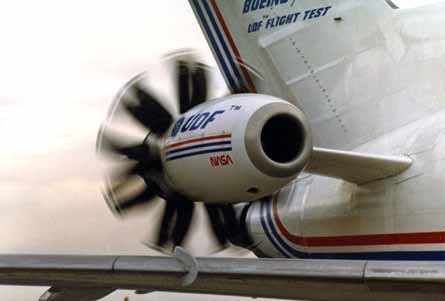CFM International is conducting preliminary studies of open rotor and other potential "game changing" architecture concepts for future narrowbody engines as part of its LEAP56 technology study, new details of which have just been revealed.
The open rotor concepts, one of which was revealed recently by CFM partner Snecma, include pusher, counter-rotating designs very similar to the General Electric GE36 unducted fan (UDF) study of the 1980s, as well as puller-type designs.
 |
|---|
| © Flight Collection |
Both options, as well as a low-noise optimised counter-rotating fan study, would build on the foundations laid by LEAP56, says CFM. LEAP56 was launched in 2005 to develop the technical foundation for the next generation of CFM56 engines.
However the company cautions that the more advanced concepts are still years away from fruition. Any open rotor design would not be ready for service until "very late in the second decade at the earliest," says CFM executive vice president Bill Clapper.
The baseline LEAP56 technology effort is geared towards an advanced conventional turbofan "that still looks like an engine," Clapper adds.
Currently timed for a target entry into service around 2015, the LEAP56 technology package is aimed at an engine with 10% to 15% lower specific fuel consumption than current engines, 15% better maintenance costs, up to 15dB lower noise and 25% longer life-on-wing.
Just as critically as its lower fuel burn, the engine would also produce lower nitrous oxide and other emissions than the CAEP 6 standards due for introduction from 2008 onwards.
To get this performance CFM has selected a higher bypass ratio of around 9:1 versus 5:1 on the current engines, as well as an ultra high pressure ratio core of more than 15:1 against the 11:1 of today's high pressure spools.
Although CFM studied a two-stage HP turbine to achieve this, it believes this performance can be reached more effectively with a 15% higher loaded single HPT stage and an eight-stage HP compressor.
"So this is definitely a different engine, even if it is a classic (CFM style) single stage," says CFM56 director of programmes, Francois Planaud.
Technology features to be evaluated include a resin transfer moulded, 3D woven composite fan blade set, a composite fan case, next-generation 3D aerodynamically designed HPC and HPT, ceramic matrix composite turbine nozzles, advanced LPT with titanium aluminide blades, and a TAPS (twin-annular pre-swirled) II combustor.
"We're now in the process of doing tests on a 70in class blade and will be doing bird strike and fatigue tests later this year, and in 2008 will run the blades on a CFM56-5C engine," says Planaud.
A series of LEAP56 component and rig tests later this year and in 2008, will transition to core and full engine tests in 2009/2010.
"At the end of that, by around 2011, we can then launch the product design," adds LEAP56 programme manager Ron Klapproth.
Whether the LEAP56 baseline targets are good enough to meet the needs of the airlines for a next-generation Airbus A320 or Boeing 737 successor remains to be seen, adds Clapper.
"This, we believe, relative to the requirements, is a very competitive offering. Whether it’s enough to satisfy the airlines or not, we just don't know yet," he says.
"We don't know when the next generation aircraft will happen, so we need a solid base technology programme to make sure we are ready."
Tests of the open rotor concept and its technology are meanwhile spaced out over a longer eight-year period, with flight tests not even provisionally planned until around 2013/2014, says CFM.
Source: FlightGlobal.com
















